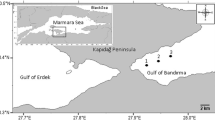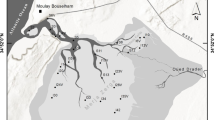Abstract
Siphonophores are exclusively marine cnidaria and their predatory role in plankton food-webs is well recognised. In this study, we analyse the structure and the spatial extent of siphonophore assemblages in relation to changes in freshwater outflows and food availability in the southern Gulf of Mexico during a high (October) and a low (April) outflow periods. A total of 149 samples were collected using a 505 μm multiple closing net at 1–6 levels (0–100 m) of the water column, depending on the bathymetry. Data on siphonophore species biovolumes (ml 100 m−3) were treated by means of the Bray-Curtis Dissimilarity Index, and two distinctive assemblages were identified: the ‘inner’ and the ‘outer’ assemblages, located over the inner and outer shelves. Temperature, salinity, zooplankton biomass, and siphonophore species were included in a Principal Component Analysis (PCA) to identify the factors associated with each assemblage. Geographical distribution of the assemblages practically remained the same during both seasons and its cross-shelf variability was stronger than the vertical one. Seasonally, diversity values were higher in October, when the highest river discharges occur. Spatially, the lowest diversity and mean siphonophore biovolumes values were registered in the ‘inner assemblage’, where the highest and lowest salinity values were recorded. We suggest that even when extreme salinity values (>36.5 or <34) might depress siphonophore populations in the coastal area, enough food availability in the concerned areas might mitigate the negative effect of salinity, since a positive and significant (p < 0.05) relationship was found between siphonophores biovolume and zooplankton biomass. Bassia bassensis, Diphyes dispar and Enneanogum hyalinum, present in both assemblages during both seasons, were able to survive in a wide range of salinity values, following perhaps, their prey. All the 23 species here registered were found in the ‘outer assemblage’; however, Abylopsis eschscholtzi, Chelophyes appendiculata and Diphyes bojani were more associated with the ‘outer’ group according to the PCA results. Enneagonum hyalinum was the only species frequently encountered and abundant in the ‘inner assemblage’ during both seasons and, supporting previous observations, this species might be considered as an indicator of nearshore waters.






Similar content being viewed by others
References
Alba-Hurtado, C., 2001. Composición, abundancia y distribución de los sifonóforos (Cnidaria: Hydrozoa), en la Bahía de Campeche, México. Bch. Thesis, Universidad Nacional Autónoma de México, Mexico, D.F.
Alvariño, A., 1968. Los quetognatos, sifonóforos y medusas en la región del Atlántico ecuatorial bajo la influencia del Amazonas. Anales del Instituto de Biología. Universidad Nacional Autónoma de México 39, Serie Ciencias del Mar y Limnología 1: 41–76.
Bray, J. R. & J. T. Curtis, 1957. An ordination of the upland forest communities of southern Wisconsin. Ecological Monographs 27: 325–349.
Czitrom, S. P. R., F. Ruiz, M. A. Alatorre & A. R. Padilla, 1986. Preliminary Study of a front in the Bay of Campeche, Mexico. In Nihoul, J. C. J. (ed.), Marine interfaces ecohydrodynamics. Elsevier Oceanography Series, Liege, 301–311.
Flores-Coto, C., L. Sanvicente-Añorve, R. Pineda-López & M. A. Rodríguez Van Lier, 1988. Composición, Distribución y abundancia ictioplanctónica del sur del Golfo de México. Universidad y Ciencia 5: 65–84.
Gasca, R., 1993. Especies y abundancia de sifonóforos (Cnidaria: Hydrozoa) en la región sur del Golfo de México. Caribbean Journal of Science 29: 220–225.
Gasca, R., 1997. Sifonóforos (Cnidaria: Hydrozoa) del Caribe Mexicano (agosto 1986). Hidrobiológica 7: 51–57.
Gasca, R., 1999. Siphonophores (Cnidaria) and the summer mesoscale features in the Gulf of Mexico. Bulletin of Marine Science 65: 75–89.
Gibbons, M. J. & D. Thibault-Botha, 2002. The match between ocean circulation and zoogeography of epipelagic siphonophores around southern Africa. Journal of the Marine Biological Association of the United Kingdom 82: 801–810.
Kassen, R., A. Bucling, G. Bell & P. B. Rianey, 2000. Diversity peaks at intermediate productivity in laboratory microcosms. Nature 406: 508–512.
Kimmel, D. G. & M. R. Roman, 2004. Long-term trends in mesozooplankton abundance in Chesapeake Bay, USA: influence of freshwater input. Marine Ecology Progress Series 267: 71–83.
Lo, W. T & D. C. Biggs, 1996. Temporal variability in the night-time distribution of epipelagic siphonophores in the North Atlantic Ocean at Bermuda. Journal of Plankton Research 18: 923–939.
Mackie, G. O., P. R. Pugh & J. E. Purcell, 1987. Siphonophore Biology. Advances in Marine Biology 24: 97–262.
Magurran, A. E., 1988. Ecological diversity and its measurement. Princeton University Press, Princeton.
Margulis, R. Y., 1972. Factors determining the large-scale distribution of siphonophores of the suborders Physophorae and Calycophorae in the Atlantic Ocean. Oceanology 12: 420–425.
Moore, H. B., 1949. The zooplankton of the upper waters of the Bermuda area of the North Atlantic. Bulletin of the Bingham Oceanography Collection, Yale University 12: 1–97.
Okolodkov, Y. B., 2003. A review of Russian plankton research in the Gulf of Mexico and the Caribbean Sea in the 1960–1980s. Hidrobiológica 13: 207–221.
Pagès, F., H. E. González, M. Ramón, M. Sobarzo & J. M. Gili, 2001. Gelatinous zooplankton assemblages associated with water masses in the Humboldt Current System, and potential predatory impact by Bassia bassensis (Siphonophora: Calycophorae). Marine Ecology Progress Series 210: 13–24.
Pugh, P. R., 1999. Siphonophorae. In Boltovskoy, D. (ed.), South Atlantic Zooplankton. Blackhuys Publishers, Leiden, 467–511.
Purcell, J. E., 1981. Dietary composition and diel feeding patterns of epipelagic siphonophores. Marine Biology 65: 83–90.
Purcell, J. E., 1997. Pelagic cnidarians and ctenophores as predators: selective predation, feeding rates, and effects on prey populations. Annales de l’Institut Océanographique Paris 73: 125–137.
Qureshi, N. A., 1997. Distribution, abundance and diversity of mesozooplankton from surface waters of the inner continental shelf of northern Gulf of Mexico. Pakistan Journal of Zoology 29: 391–403.
Rosenzweig, M. L. & Z. Abramsky, 1993. How are diversity and productivity related? In Ricklefs, R. E. & D. Schluter (eds), Species diversity in ecological communities: historical and geographical perspectives. University of Chicago Press, Chicago, 52–65.
Silguero, J. M. B. & B. H. Robison, 2000. Seasonal abundance and vertical distribution of mesopelagic calycophoran siphonophores in Monterey Bay, CA. Journal of Plankton Research 22: 1139–1153.
Suárez-Morales, E., R. Gasca, L. Segura-Puertas, & D. C. Biggs, 2002. Planktonic cnidarians in a cold-core ring in the Gulf of Mexico. Anales del Instituto de Biología, Universidad Nacional Autónoma de México (Zoología) 73: 19–36.
Thibault-Botha, D., J. R. E. Lutjeharms & M. J. Gibbons, 2004. Siphonophore assemblages along the east coast of South Africa; mesoscale distribution and temporal variations. Journal of Plankton Research 26: 1115–1128.
Vázquez-de-la-Cerda, A. M., R. O. Reid, S. F. DiMarco & A. E. Jochens, 2005. Bay of Campeche circulation: an update. In Sturges, A. & A. Lugo-Fernández (eds), Circulation in the Gulf of Mexico: observations and models. Geophysical Monograph Series 161, American Geophysical Union, Washington, DC, 279–294.
Viitasalo, M., I. Vuorinen & S. Saesmaa, 1995. Mesozooplankton dynamics in the northern Baltic Sea: implications of variations in hydrography and climate. Journal of Plankton Research 17: 1857–1878.
Zavala-Hidalgo, J., S. L. Morey & J. J. O’Brien, 2003. Seasonal circulation on the western shelf of the Gulf of Mexico using a high-resolution numerical model. Journal of Geophysical Research 108(C12) 3389 doi: 10.1029/2003JC001879 2003.
Acknowledgements
Authors express their gratitude to Drs K. Martens, D. Biggs, and one anonymous reviewer for their comments and interest in this paper. We also thank F. Zavala-García, I. Ruiz-Boijseauneau and A. Martínez-Nicolás for their technical assistance, to the G27777-B project (CONACYT) for sponsoring field surveys, and to the PAPIIT-UNAM project number IN218405-2 for the additional financial support.
Author information
Authors and Affiliations
Corresponding author
Additional information
Handling editor: K. Martens
Rights and permissions
About this article
Cite this article
Sanvicente-Añorve, L., Alba, C., Alatorre, M.A. et al. Cross-shelf and vertical distribution of siphonophore assemblages under the influence of freshwater outflows in the southern Gulf of Mexico. Hydrobiologia 586, 69–78 (2007). https://doi.org/10.1007/s10750-006-0492-6
Received:
Revised:
Accepted:
Published:
Issue Date:
DOI: https://doi.org/10.1007/s10750-006-0492-6




